What a strange time and place I live in, where I can choose who to pay for my electricity.
Before 2017, I paid for household electricity according to the traditional model (where you just pay The Electric Company for where you live.) These were the Halcyon Days when Certain Things About Adult Life Could Be Relied Upon, and the cost of fungible commodities was kept in check by the definition of ‘fungible’. But then I moved into a house that was located in one of Texas’ Electric Choice areas, so I had to quickly try and piece together what in the hell this meant and how to deal with it.
So I dove into “Power to Choose” and immediately found it was more like “Paralysis of Choice” since entering my new Zip Code resulted in over 100 offers. Immediately I started looking around for The Default (like I was used to) only to find there…wasn’t one.
So, putting that aside for the moment, I tried to get some background on Electric Choice and Why It Was A Thing. It seems that in 2002, much of Texas switched over to an un-bundled retail electrical service model where consumers could pick what company they paid for their power while still living in the same place, expecting that the competition this introduced would naturally drive down costs (like it always does, right? [/sarcasm])
It reminded me of the competitive natural gas companies that had started to creep into the market in Metro Detroit around the time I graduated college…
Up until then, you paid The Gas Company (TM) for your home, and since they handled both the supply and distribution, they held a functional monopoly on their energy service and could charge whatever they wanted (within reason.) After deregulation started, these “competitive” nat gas providers popped up that could plug directly into the existing infrastructure and charge customers directly, theoretically resulting in a lower overall price.
In reality, after Competitive Co. takes their (presumably lower) base rate and adds their own overhead, then passes through the distribution costs from BigOldGas Co., you’re still gonna (long-term) come out at more or less the same rate per CCF of natural gas no matter what. Especially when BigOldGas Co. still provides direct-to-consumer service and is (again, more or less) still in control of what “distribution cost” they add to the “gas only” cost from Competitive Co.
NB from the future: I never really found out if these competitive natgas providers were actual suppliers or just resellers. They could easily have been either.
Texas’ Electric Choice goes a step further. Distributors (Transmission and Distribution Utilities or TDUs) are strictly in charge of maintaining the grid, Suppliers are strictly in charge of providing power to the grid, and the Retail Electric Providers (REPs) are the customer interface – they are in charge of buying power production from suppliers, calculating the usage costs from the TDUs, adding their own “value” and billing it all to the Consumers.
Congratulations, Texas! It’s (another) bureaucratic nightmare! So what do we get for it?
Well, market competition among the producers and REPs does effect a certain amount of synergy. For example, REPs are incentivized to buy electric production for the lowest price they can, and consumers can sign up for 100% Renewable Energy plans from their REP and (indirectly) put pressure on the market for more renewable energy production (assuming the REP actually follows through with stated customer choice.)
But does the consumer save money? Well like a lot of things in Texas, they can, if they work for it. The recommended process for saving the most money with Electric Choice looks like this:
Step 1: Sign up with a REP on a low introductory fixed-price contract
Step 2: At the end of that contract, switch to a new REP on a low introductory fixed-price contract
Step 3: Repeat until the heat death of the universe (or, I guess, the end of Having To Pay Money For Things Everyone Needs.)
Consumers can find REPs through various Government-provided and independent comparison websites, as well as Direct-to-Customer advertising. I get pinged pretty frequently by one provider which offers “your 7 highest use days free automatically!” on a laughably high fixed-price contract.
And if you’re really strapped for time, you can always pay a consultant to find the best deals for you. I’m not going to link to any because I don’t endorse Commercial and Industrial Electric Sourcing Advisors preying on Residential electric customers that have orders-of-magnitude lower consumption.
My experience with all this has been . . . interesting.
My first year, on an introductory low fixed-price “100% renewable” contract, was basically transparent to me, and since I didn’t know what my average usage and cost was going to be in a new house, I didn’t have a basis for comparison. I renewed with the same company for convenience (and before I knew I should always switch to keep my costs down.)
It was shortly after I renewed that I started seeing ads for Griddy. Here was a REP who was offering a single indexed-rate plan, no minimum term, no cancellation fees, no frills, just a $10/month membership cost. The index that the rate was tied to was the wholesale electrical market (administered by ERCOT) – basically a rate which changes every 15 minutes based on supply and demand on the shared electrical grid.
Whoa, what? How could a constantly changing rate benefit the consumer? Well, because over the course of a full year, the average rate of a wholesale-indexed plan will pretty much always come in at less per kWh than anything but the lowest introductory fixed-rate plans. A changing rate also allows you to move your usage around based on the normal rate cycle to save even more money – something I have gotten particularly good at lately.
Griddy stuck around in the back of my mind during the second year, then when I got the e-mail from my REP telling me my fixed-price contract was over (and offering me a ridiculously higher fixed-rate plan,) I immediately switched.
Make Electricity Fungible Again! #rejectedgriddyslogans
And, for the last 10 days of April, and all of May and June, I did pay a lot less for my power than I had the previous year – more than a full cent per kWh on average (and those couple pennies become $20 bills fast). July got a bit harder as the Texas heat set in, but overall I was still hovering right around a cent better, on average.
Now that I was over three months in, I had seen the way the normal price cycle worked during the day and had seen how reducing consumption during peak hours (1-6pm) was a generally good idea. On August 6th, I sucked it up and turned my AirCon off completely during that time just to see how much it would impact my daily cost. It was admittedly crazy, but it was one day and I didn’t have the kids to worry about.
Griddy provides a bunch of data visualizations through their app and website, and as a data nerd I can both appreciate and criticize these in equal measure. One thing I wish they still had was a combined usage and price chart (they had this when I started, then it went away with a shiny new visualization engine) but I can still simulate them with Photoshop.
So here’s August 5th (my ‘control’ day,) where I kept the AirCon set at a steady 74F (23C) all day:
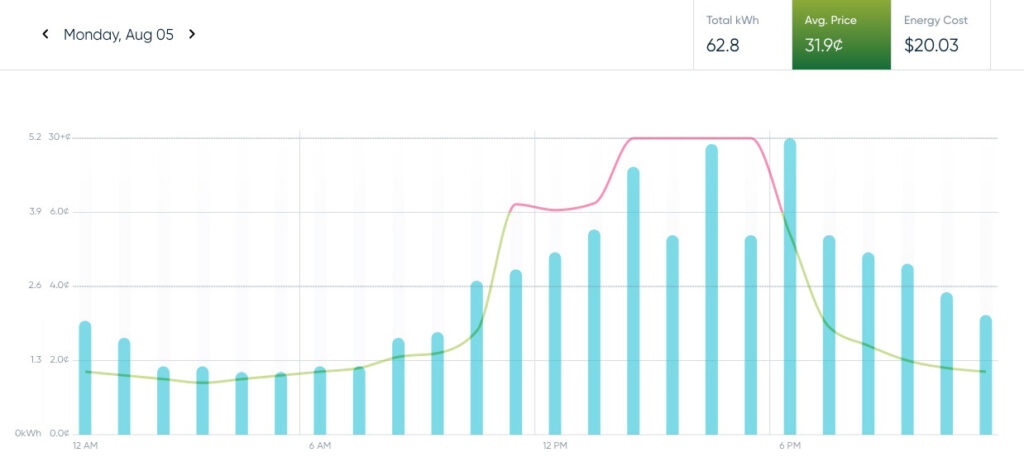
As you would expect, usage increases during peak time (since the AirCon is running more often because it’s HOT in Texas) and that means more electricity when it costs more, resulting in about $20 total electricity cost for the day.
Cool. Here’s August 6th, where I killed the AirCon completely during peak time:
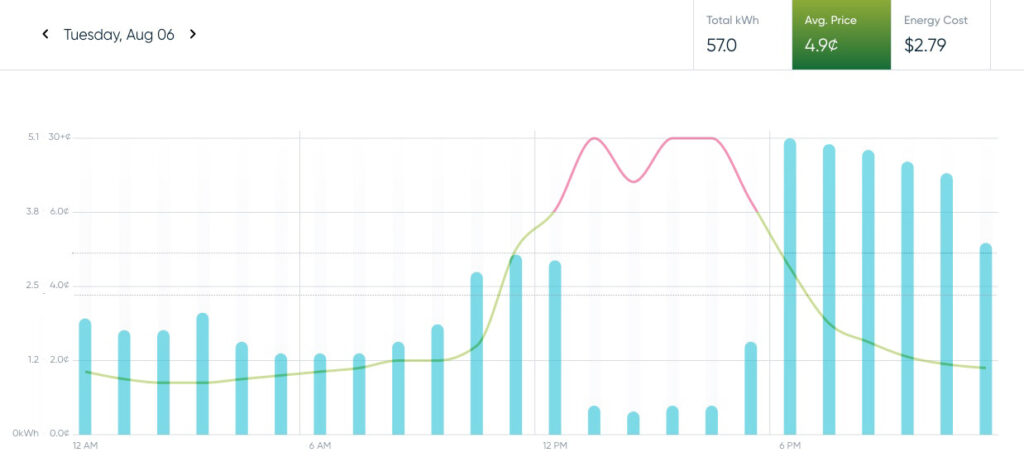
As expected, a sharp decrease in usage during times when the cost was highest, then a sharp increase when I kicked it back on when prices were already retreating to normal off-peak levels. When all was said and done, the cost for a day where I used roughly the same amount of power as the control was cut by ~90%. Oh, and my expected monthly account recharge happened on this day too, but more on that later.
Ok, this all makes sense. Use less stuff when cost of stuff is high = pay less money for stuff. But turning your AirCon off in Texas during the hottest part of the day? Decidedly sub-optimal. What I can do instead is set it to 78F (26C), which is, of course, that magic number that some “Federal Guideline” states. So I did that the following day.
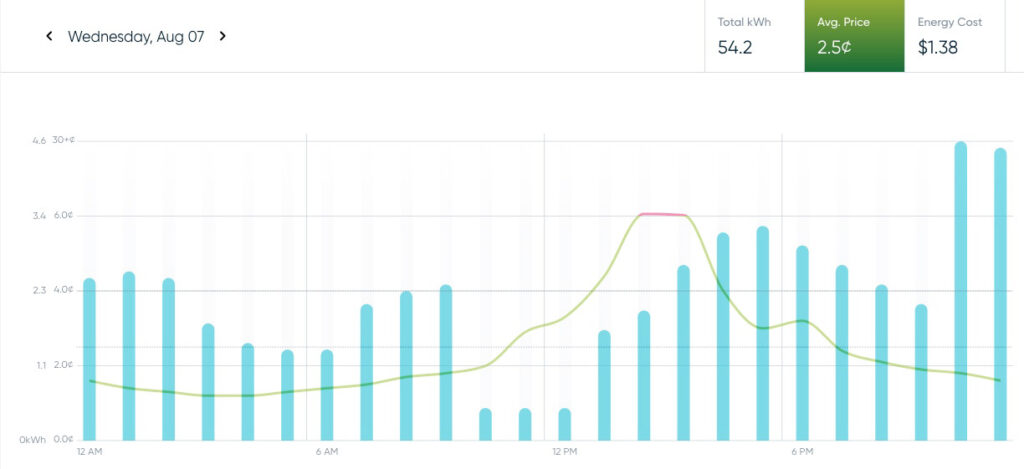
Even after leaving it at 78 for longer than peak hours, my consumption by end of day was still within 10 kWh of what it had been on the “control” day. Taken with a lower average price that day, of course, I came out even better.
So what did I learn? Well, not enough, clearly . . .
Shit really started to hit the fan that weekend, and the number of e-mails I would get from Griddy advising me of higher-than-normal pricing went from “every once in a while” to “daily.” ERCOT issued advisories (where the operating reserve on the grid falls below 3,000 MW) all weekend and again on the following Monday, when the grid experienced a new record demand at 74,531 MW. You might have heard about that.
So I got in the habit of setting the thermostat to 78 once the peak time started, and didn’t really think much about it other than that. I did the same on Tuesday August 13, which turned out to be a day that ERCOT issued an EEA1 (Energy Emergency Alert 1) as the demand pulled the operational reserve below 2,300 MW for an extended period.
What this meant for me? Regulatory Maximum Price for around an hour and a half.
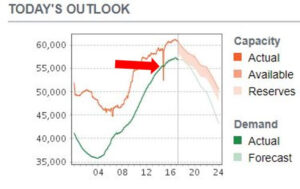
So, funny story about Regulatory Maximum Price – a lot of us Griddyers last heard about this in late May when a glitch in ERCOT’s telemetry systems falsely reported a loss of 4,000 MW of supply for a five-minute polling interval. This caused the price for that interval to go as high as it could go – $9 per kWh. Still, smart meters can only measure in 15 minute intervals so they average the three 5-minute prices to determine the wholesale price that will be charged for each 15 minutes. However, it still meant the rate for that 15 minutes was well over $5, I think. Griddy actually refunded us for the difference between what it was and what it should have been because it was ridiculous for us to pay extra for an artificial spike caused by ERCOT’s telemetry errors.
Anyway, here’s what Aug 13 (the EEA1 Tuesday) looked like for me, still rocking the “oh I’ll just kick it down to 78 when it gets bad” plan:
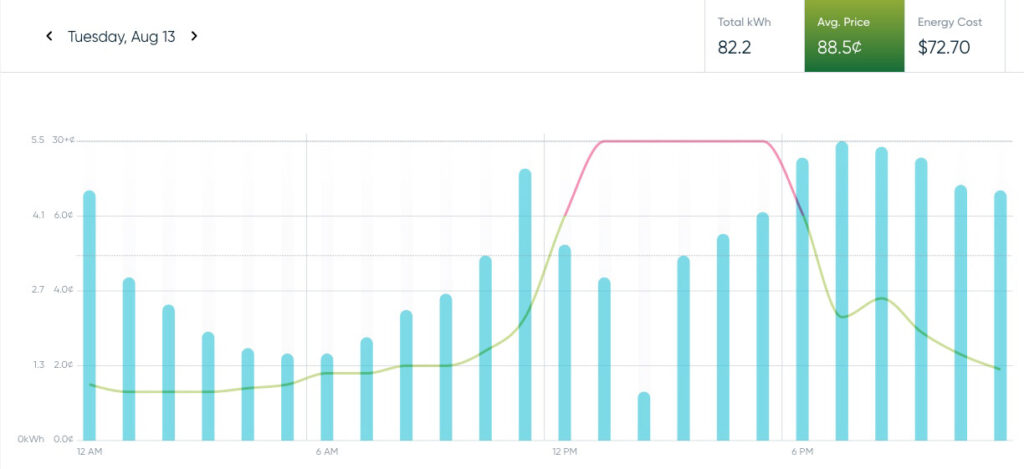
OUCH.
This, plus the high costs of the previous 3 days actually caused my balance (Griddy is a prepay/recharge-below-account-threshold thing, like a Starbucks card) to trigger a recharge (the second of the month) the following day. Since Griddy passes through their Merchant Services fees, two recharges in one month is not great news for a lot of reasons.
Again, not learning anything, I continued charging forward with the “78F during peak and pray” plan, though I think I got distracted and was a bit late to the price surge and another EEA1 party two days later…

BIG OUCH. And this is ELECTRICITY ONLY cost, the TDU charges get added on top of that. This set me up for a third recharge not even two days after the second.
Now greatly distressed and questioning every decision I ever made, I awoke Friday morning not knowing how bad Thursday had actually been yet and wondering what I could do, other than run screaming from Griddy. While considering it would take up to 5 days to switch, and thinking about the BS involved picking a new REP, I managed to remember something they suggested in the conservation recommendations that I had been seeing every day for a week at that point – “pre-cooling” the house when the prices are low, then switching off (or setting the thermostat high) once peak starts.
How much of a difference could pre-cooling really make?

Vive la difference.
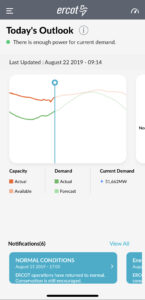
Since then, I have also found out that ERCOT has an app as well that shows me the Projected/Actual Supply and Demand charts throughout the day, and taken with Griddy’s own dynamic rate forecasts, I am able to quickly plan my AirCon strategy for the day each morning. Usually this means I set the thermostat to a bone-chilling 72F (22C) (which, I’ve discovered, is the lowest I can possibly cool my house) until peak time sets in at around 12noon-1pm, then either switch off the AirCon entirely (not really optimal) or set to 78F and let the temperature slowly rise (AirCon free) over 2-3 hours until it hits the set point again, then the AirCon acts as a dehumidifier and keeps it from getting unbearably hot in the house. Then at around 6pm I can drop it to the “normal/overnight” 74F and do it all again the next day.
So, is all the shit I have to do to make wholesale-indexed pricing work for me actually… worth it?
Jury is still out on that point, but I do have to remember the most important thing about this: The savings are not supposed to be realized over a day, or a week, or a month. It’s over the whole year. And what that means is maybe a month of suckiness will pay out huge dividends over the course of a year, especially because I’m (now) willing to be more judicious about how and when I use the bulk of my electricity. AirCon, Dishwasher, and Laundry Machines can all be used in off-peak without much trouble.
Another thing that has been brought up is that the record demand this month means that Electricity Futures will absolutely drive the cost of fixed-price plans up over the next year. This was already happening back in April when I got my contract renewal offer with my old Fixed-Price REP and it was an increase of like 5 cents per kWh over what I had been paying (which was already a full 3 cents higher than my introductory year.) This was because their cost for the power they were going to re-sell me was anticipated to shoot up in price during the coming summer (the market knew this as far back as last November, I discovered.) Instead, I’ve been buying that power (more or less) at cost this whole time.
So in the short-term, yeah, indexed pricing can suck a fat one, but combine that with using electricity smarter, figuring out better ways to handle potential mid-month recharges, and zooming my expectations out a bit and it’s probably gonna work out fine.
I’m glad I have the resources to experiment. Not many people do.